Observing the patterns of rain and measuring the amount of rain is a great step in understanding the weather.
 |
 |
What you will need:
- A container, preferably one with a large mouth and straight sides
- A measuring cup or jug
What you will do:
1 Talk with your group about rainy weather—are there more rainy days than dry ones? Does rain happen more often in some seasons? Does it usually rain all day or just for a little while?
2 Your group is going to make a rain gauge. Where would be the best place to put it in your school?
3 Your teacher will give you a container to use for your rain gauge. Put it where you think it will catch the most rain today.
4 This afternoon, collect your rain gauge and carefully pour it into a measuring cup or jug to find out how much rain there is.
5 Try it again on another rainy day. Was there more or less rain?
What is going on?
Every day the amount of rain that falls is different. Some days there is no rain, others are very wet!
Plants need rain to grow and we like to know when it is going to rain so we can plan our activities, so the weather forecasters like to record which days it rained and measure how much rain fell so they can look for patterns.
Monster Challenges:
- Can you make up a table for recording the rainy days and how much rain fell? Keep your record for a few weeks, then make a graph of your results.
Teaching Notes:
Topic: Rain Gauge
Key Concepts:
¨ Observing rain
Resources:
- Investigation Record IR01– one copy per student
- Experiment Description Weather W10 – one copy per student
- Containers with wide necks and straight sides, measuring cups or jugs
Lesson Notes:
Remind students to listen carefully to instructions, and to OBSERVE their experiment.
As a class discuss the experiment prior to undertaking it, and talk about what students know about rain—perhaps make a brainstorm list including how often it rains, for how long, how heavy or light rain sounds, if there are seasonal fluctuations etc.
Discuss good areas to place their rain gauges—they need to be away from overhanging branches etc and also consider putting them somewhere that other students are not going to knock them over.
Students should then complete the sections of their Investigation Report IR01 from ”Title to “Hypothesis”.
What should happen in this experiment, and why?
Unless you have a huge downpour the amount of water you collect will probably be quite small—it depends on the size of the mouth of your container. If it is very small you might decide to measure all the rain gauges together. The number you get will only correlate to future experiments using the same containers—the way rainfall is measured by meteorologists uses a specific standardized method.
Follow up discussion questions:
- If we measured the rain for a whole year, what sort of areas might have more rain than us? What might have less?
- What do we call it when for a long time there is not enough rain? [drought]
- What happens when there is too much rain all at once? What happens to our creeks and rivers?
Get this experiment here or as part of a bundle of Weather Experiments here.



